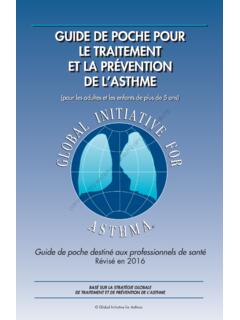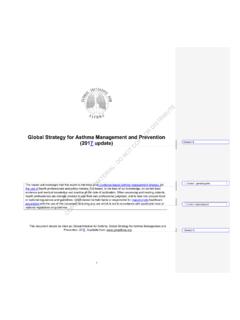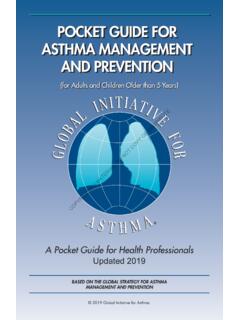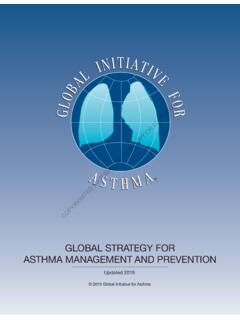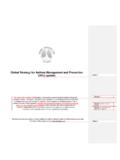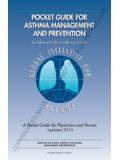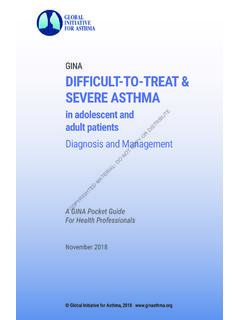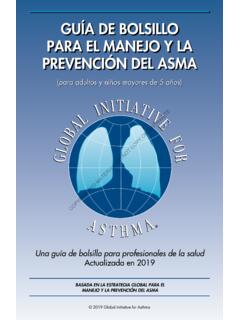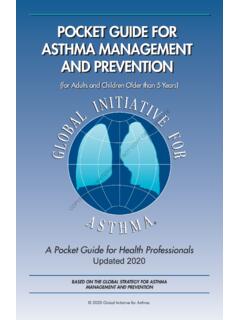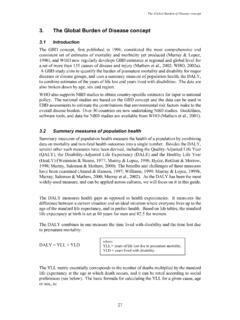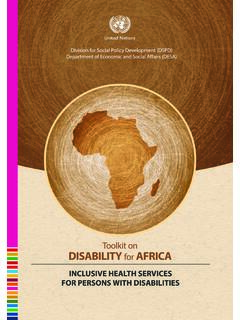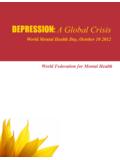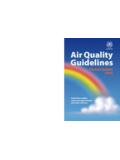Transcription of GINA DIFFICULT-TO-TREAT & SEVERE ASTHMA
1 GLOBAL. INITIATIVE. FOR ASTHMA . GINA. DIFFICULT-TO-TREAT &. SEVERE ASTHMA . in adolescent and TE. U. IB. adult patients TR. IS. D. R. O. Diagnosis and Management PY. O. C. T. O. N. O. D. L- IA. ER. AT. M. D. TE. H. IG. R. PY. O. A GINA Pocket Guide C. For Health Professionals April 2019. Global Initiative for ASTHMA , 2019 GINA. DIFFICULT-TO-TREAT &. TE. SEVERE ASTHMA . U. IB. TR. in adolescent and IS. D. R. adult patients O. PY. O. Diagnosis and Management C. T. O. N. O. -D. L. IA. ER. AT. M. D. TE. A GINA Pocket Guide H. IG. For Health Professionals R. PY. O. C. April 2019. Global Initiative for ASTHMA , 2019 Abbreviations used in this Pocket Guide Table of Contents +++, ++, +: Plus signs indicate the strength of an association Abbreviations used in this Pocket ABPA: Allergic bronchopulmonary aspergillosis Goal of this Pocket 4.
2 AERD: Aspirin-exacerbated respiratory disease How to use this Pocket 5. ANCA: Antineutrophil cytoplasmic antibody Definitions: uncontrolled, DIFFICULT-TO-TREAT and SEVERE BNP: B-type natriuretic peptide Prevalence: how many people have SEVERE ASTHMA ? CBC: Complete blood count (also known as FBC, full blood count) Importance: the impact of SEVERE COPD: Chronic obstructive pulmonary disease SEVERE ASTHMA decision tree: diagnosis and CRP: C-reactive protein TE. Investigate and manage adult and adolescent patients with U. CT/HRCT: Computerized tomography; high resolution computerized tomography DIFFICULT-TO-TREAT ASTHMA IB. CXR: Chest X-ray TR. GP OR SPECIALIST CARE Decision Detail DPI: Dry powder inhaler Tree Pages IS. D. DLCO: Diffusing capacity in the lung for carbon monoxide 1 Confirm the diagnosis ( ASTHMA or differential diagnoses).
3 16. R. 2 Look for factors contributing to symptoms, . O. FeNO: Fraction of exhaled nitric oxide exacerbations and poor quality of life .. 17. PY. FEV1: Forced expiratory volume in 1 second O. 3 Optimize management .. 18. FVC: Forced vital capacity C. 4 Review response after ~3-6 months .. 19. T. GERD: Gastro-esophageal reflux disease O. N. GP: General practitioner; primary care physician O. ICS: Inhaled corticosteroids Assess and treat SEVERE ASTHMA phenotypes -D. SPECIALIST CARE; SEVERE ASTHMA CLINIC IF AVAILABLE. L. Ig: Immunoglobulin IA. IL: Interleukin ER 5 Assess the SEVERE ASTHMA phenotype and factors contributing to symptoms, quality of life and exacerbations .. 20. AT. IM: Intramuscular 6a Consider non-biologic treatments .. 22. M. IV: Intravenous D. L: Check local eligibility criteria for specific biologic therapies as these may vary 6b Consider add-on biologic Type 2 targeted treatments.
4 23. TE. from those listed H. IG. LABA: Long-acting beta2-agonist Monitor / Manage SEVERE ASTHMA treatment R. LM/LTRA: Leukotriene modifier/leukotriene receptor antagonist PY. SPECIALIST AND PRIMARY CARE IN COLLABORATION. O. NSAID: Non-steroidal anti-inflammatory drug 7 Review response .. 28. C. OCS: Oral corticosteroids 8 Continue to optimize management as in section 3 .. 29. OSA: Obstructive sleep apnea pMDI: Pressurized metered dose inhaler Glossary of ASTHMA medication classes .. 31. RCT: Randomized controlled trial Acknowledgements, GINA publications, other resources for SEVERE SABA: Short-acting beta2-agonists SC: Subcutaneous VCD: Vocal cord dysfunction (now part of inducible laryngeal obstruction). 2 Adolescents and adults with DIFFICULT-TO-TREAT and SEVERE ASTHMA GINA 2019 Adolescents and adults with DIFFICULT-TO-TREAT and SEVERE ASTHMA GINA 2019 3.
5 Goal of this Pocket Guide How to use this Pocket Guide The goal of this Pocket Guide is to provide a practical summary for health The Table of Contents (page 3) summarizes the overall steps involved in professionals about how to identify, assess and manage DIFFICULT-TO-TREAT and assessing and treating an adult or adolescent who presents with DIFFICULT-TO-TREAT SEVERE ASTHMA in adolescents and adults. It is intended for use by general ASTHMA (see definitions on page 6). practitioners (GPs, primary care physicians), pulmonary specialists and other A clinical decision tree is found on pages 8 to 15, providing brief information health professionals involved in the management of people with ASTHMA . about what should be considered in each phase. The decision tree is divided into More details and practical tools for ASTHMA management in clinical practice, three broad areas: particularly for primary care, can be found in the GINA 2019 strategy report and Sections 1-4 (green) are for use in primary care and/or specialist care appendix and the online GINA toolbox, available from Sections 5-7 (blue) are mainly relevant to respiratory specialists TE.
6 How was the Pocket Guide developed? Section 8 (brown) is about maintaining ongoing collaborative care between the patient, GP, specialist and other health professionals U. The recommendations in this Pocket Guide were based on evidence where IB. good quality systematic reviews or randomized controlled trials or, lacking these, TR. robust observational data, were available, and on consensus by expert clinicians Overall aim of IS. Locus of care: the sections on Reminders about and researchers, where not. D. GP or specialist this double page ongoing issues R. Development of the Pocket Guide and decision tree included extensive O. collaboration with experts in human-centered design to enhance the utility PY. GP OR SPECIALIST CARE. of these resources for end-users. This means translating existing high level Investigate and manage adult and adolescent patients with DIFFICULT-TO-TREAT ASTHMA O.
7 Flowcharts and text-based information to a more detailed visual format, and C. Consider referring to specialist or SEVERE ASTHMA clinic at any stage Consider referring to specialist or SEVERE ASTHMA clinic at any stage applying information architecture and diagramming principles. T. DIAGNOSIS: 1 Confirm the diagnosis 3 Optimize management, 4 Review response O. Difficult- to-treat ( ASTHMA /differential including: after ~3-6 months ASTHMA . N. diagnoses). 2 Look for factors ASTHMA education O. For adults and Optimize treatment ( DIAGNOSIS: adolescents with contributing to symptoms, Is ASTHMA yes If not done by now, check and correct inhaler SEVERE symptoms and/or -D. exacerbations and poor technique and adherence; still uncontrolled? refer to a specialist, Circles indicate exacerbations despite ASTHMA if possible. quality of life: switch to ICS-formoterol GINA Step 4 maintenance and reliever treatment, or taking diagnosis therapy, if available).
8 This GINA Pocket Guide is intended as a practical guide for health Incorrect inhaler technique maintenance OCS. L. Suboptimal adherence Treat comorbidities no and modifiable risk factors IA. Comorbidities including obesity, GERD, chronic Consider non-biologic professionals about the assessment and management of DIFFICULT-TO-TREAT rhinosinusitis, OSA add-on therapy ER. ( LABA, tiotropium, Restore previous dose Modifiable risk factors and LM/LTRA, if not used) Consider stepping triggers at home or work, and SEVERE ASTHMA . It does NOT contain all of the information required including smoking, environ- Consider non-pharmaco- down treatment, mental exposures, allergen logical interventions ( OCS first (if used.). AT. exposure (if sensitized on smoking cessation, skin prick testing or specific exercise, weight loss, for managing ASTHMA .))
9 The Pocket Guide should be used in conjunction Does IgE; medications such as mucus clearance, Key ASTHMA become beta-blockers and NSAIDs) influenza vaccination) yes M. uncontrolled when Overuse of SABA relievers Consider trial of high dose treatment is stepped with the full GINA 2019 report. Health professionals should also use ICS, if not used down? Medication side effects Key section of D. decision, Anxiety, depression and Diamonds indicate filters social difficulties the decision no TE. their own clinical judgment and take into account any local restrictions decision points tree, numbered intervention, or payer requirements. GINA cannot be held liable or responsible for H. treatment Continue optimizing management IG. inappropriate healthcare associated with the use of this document, diagnosis, Colored R. confirmation including any use which is not in accordance with applicable local or boxes indicate PY.
10 Treatment For more details national regulations or guidelines. O. C. Page number for more details More detailed information about each of the numbered sections of the decision tree follows on pages 16 to 30. Key references and additional resources are found at the end of the Pocket Guide, starting on page 31. 4 Adolescents and adults with DIFFICULT-TO-TREAT and SEVERE ASTHMA GINA 2019 Adolescents and adults with DIFFICULT-TO-TREAT and SEVERE ASTHMA GINA 2019 5. Definitions: uncontrolled, DIFFICULT-TO-TREAT and SEVERE ASTHMA Importance: the impact of SEVERE ASTHMA Understanding the definitions of DIFFICULT-TO-TREAT and SEVERE ASTHMA starts with the The patient perspective concept of uncontrolled ASTHMA . Uncontrolled ASTHMA includes one or both of the Patients with SEVERE ASTHMA experience a heavy burden of symptoms, following: exacerbations and medication side-effects.
